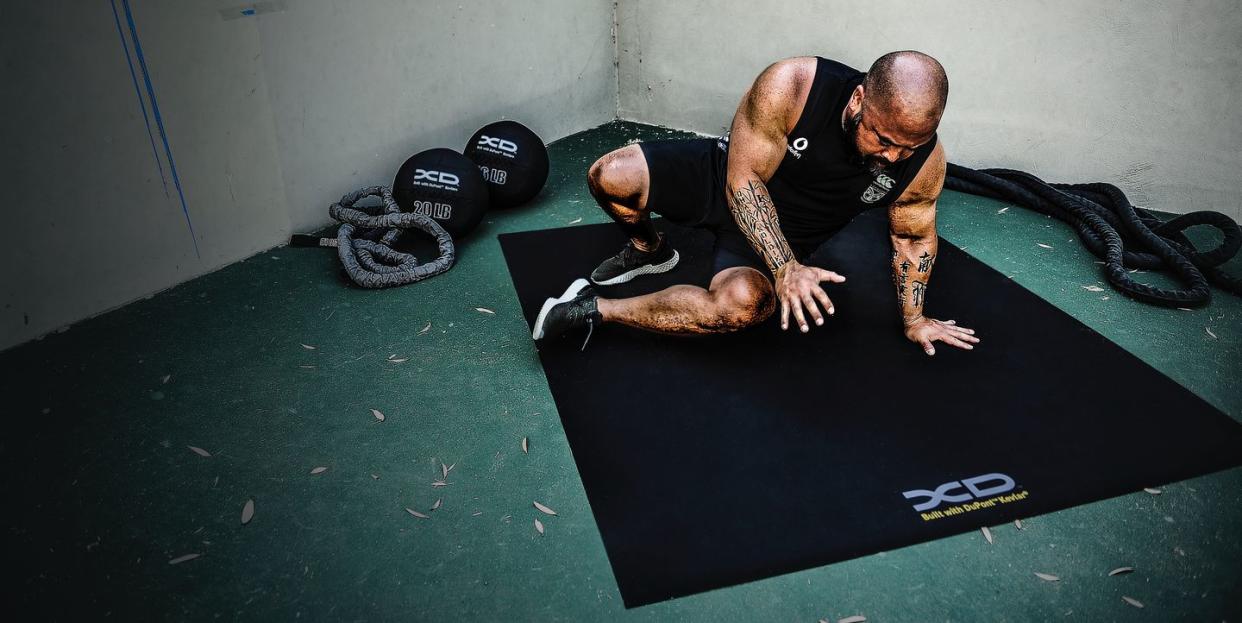This MMA-Inspired Move Will Get Your Body Even Stronger

Weights have their place-and often, that place is in your hands or on your back as you squat, bench, or deadlift your way to a new PR. But sometimes, your own bodyweight is all it takes to get a great workout.
Proving that daily is Rulk (aka Da Rulk, if you're being formal), a functional strength and conditioning specialist who trains first responders, elite military, pro athletes, and even Thanos (well, Josh Brolin). He’s also a featured trainer on Chris Hemsworth's new fitness app, Centr.
What you can expect from Rulk's brand of training might be best exemplified by the sit-thru, a move he says he does 1,000 reps of per day. The exercise is a variation of the classic wrestling sit-out. “I work with a lot of wrestling and UFC fighters,” explains Rulk. “In a sit-out, you're on your hands and knees with someone behind you, and you kick your leg out to hook around, spin around your opponent and get them off your back. That's really where it came from.”
Rulk notes that sit-outs are great for wrestling and jiujitsu drills, but when kicking out to escape a hold, you end up putting a lot of strain on your shoulder girdle. That’s why he prefers the more contained sit-thru-it’s safer for the shoulders.
Much of Rulk’s training is based on a curriculum he created called Raw Functional Training (RFT), which focuses on bodyweight movements to improve mobility and increase functional strength. Sit-thrus do exactly that. He notes that they promote shoulder stability, activate the core, mobilize the hips, work the pecs and quads and, if you do enough of them, they seriously test your conditioning.
Sit Thru Flow #RFT #DaMovement
A post shared by Rulk (@da_rulk) on Feb 28, 2019 at 10:10am PST
Thankfully, you don’t have to start out doing 1,000 sit-thrus per day. Instead, Rulk suggests aiming for 100, broken down into five sets of 20. If you can do that, then see how many you can do in a row. If you can do 30, great-next time try five sets of 30. As you progress, you'll find that your shoulders and core get stronger.
“Sit-thrus are great to add to an upper body circuit,” says Rulk. “It's a good compound motion that will burn out your shoulders.”
He also likes to bang out some sit-thrus as a warmup to loosen up the shoulders and hips while firing up the core. “They’re a great addition to add to dynamic stretching, lunges, and crawl work to get the body moving through a variety of different planes.”
How to Do the Sit-thru
When first starting out, Rulk suggests keeping both hands glued to the ground and simply driving your knees forward toward your elbows. This will get you used to the movement. Once that feels good, you can begin lifting one hand up and rotating your knee through toward the opposite arm. Once you get the hang of it, it should go something like this:
Set up in a crawl position with your hands under your shoulders and your knees underneath your hips. Balance on your hands and toes.
Lift your right hand off the ground, and drive your left knee forward toward your right hand while keeping your core engaged. Your shoulders should remain as forward and square as possible during this movement. Rulk says to imagine you’re using your knee to push a pile of dirt toward your hand.
Return to the starting position, and repeat the motion on the opposite side, raising your left hand and driving your right knee toward that hand.
Rulk mentions that some people like to extend their leg and kick their foot out on each rep, but he prefers to keep his knees bent. This contains the movement and keeps the focus on your core.
Sit-Thru Variations
Once you’ve mastered the basic move, you can try a couple of variations to test your mettle. One of Rulk’s favorite variations adds a pushup to the mix. Because your knees are under your hips for the sit-thrus, and then your legs thrust back for the pushups, it adds an element of conditioning while also working your chest.
Another option is to perform traveling sit-thrus, in which you move forward as you go. Instead of landing in the starting position, you'll place your raised hand about one hand length ahead each time.
A post shared by Rulk (@da_rulk) on Jan 13, 2019 at 6:00pm PST
Rulk notes that it’s especially important here to maintain the foundational crawl position rather than overextending your body. You want to stay tight and contained to maintain good form.
“If you do it correctly, it’s hard,” says Rulk. “But it's like swimming. Once you get the technique correct, you can go for a longer duration with more efficient movement.”
('You Might Also Like',)

